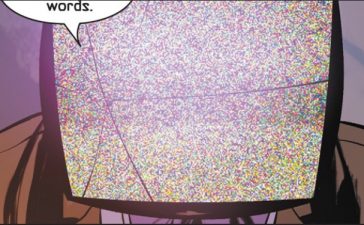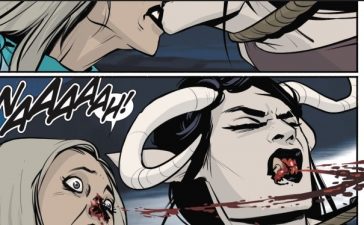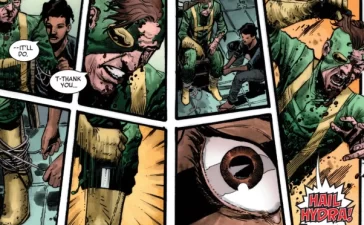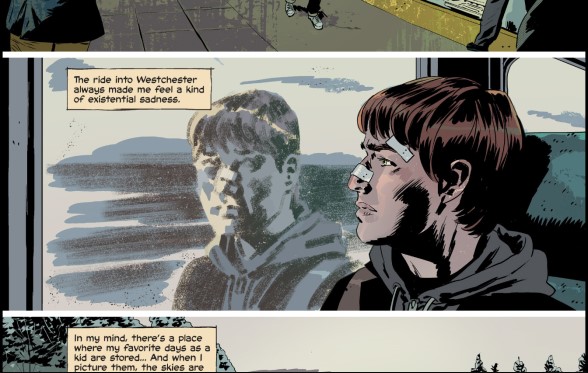
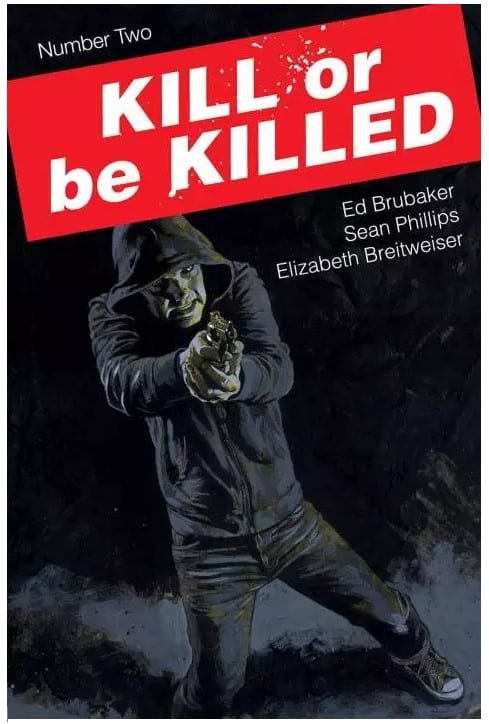
By Ed Brubaker, Sean Phillips & Elizabeth Breitweiser
Some weeks the choice is easy. This is not to say that there were not several great comics released today, because there were; in fact, there was not a dud in my stack. However, despite all the quality, sometimes there is a single issue which simply seizes your attention from the first page, immediately drawing you into the richness of its story, the lushness of its art. By about page five, you know it already: this most likely is the finest book of the week. Such was the case this week with Kill or Be Killed #2.
One reason for this is the extraordinary storytelling skills of writer Ed Brubaker. Brubaker has a knack for drawing the readers’ interest into the folds of his narrative. The voices of his protagonists are clear, compelling and quite captivating. They always have just the right turn of phrase. This is true of Kill or Be Killed #2 which opens with protagonist Dylan discoursing on his favorite story. Given the genre elements of Brubaker’s writing, readers might naturally assume that what follows would be an ode to Raymond Chandler, James Cain or one of the other great pulp authors. Yet, against expectations, Brubaker swerves in another direction, citing Kafka and Nabokov, before settling on a chapter from One Thousand and One Nights.
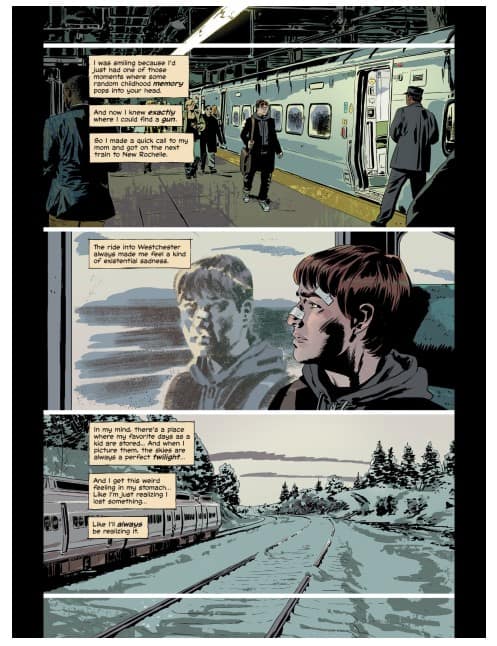
The tale in question concerns an accidental death and the fumbling attempts to shift blame in various directions. There is a happy ending about owning up to guilt, but Dylan dismisses it. For him the lesson concerns humanity’s self-interest, the absurd lengths people will go to pass the buck. That is how fiction mirrors life, in that guilt means nothing and the strong prey upon the weak. Perhaps, in the end, Scheherazade’s fantasy realm is not that far removed from those shadowy side streets frequented by Phillip Marlowe?
Guilt is the primary motif of this installment of the series. Last issue, Dylan hit rock bottom, literally, when he tossed himself off the roof of his apartment building. Miraculously he survived. Well, “miraculous” might not be the best choice of words. Dylan is now haunted by a demon which promises Dylan a new lease on life, if Dylan simply kills people for it. Not random, innocent targets, but guilty criminals of Dylan’s own choosing. Much of #2’s narrative concerns Dylan selecting his target (Mark, the brother of a childhood friend). Despite the heinous nature of the Mark’s transgression, Dylan still finds himself struggling with whether to pull the trigger of not. Mark’s crime was years ago. Perhaps amends have been made, faults reformed. Or are those another set of excuses? Despite Dylan’s confession that he does not recall the encounter clearly, he swears that he saw a look of recognition in Mark’s eyes when Dylan called out Mark’s past acts. Or was that a form of self-justification, not simply for the present, but also for Dylan’s own sins of omission in the past?
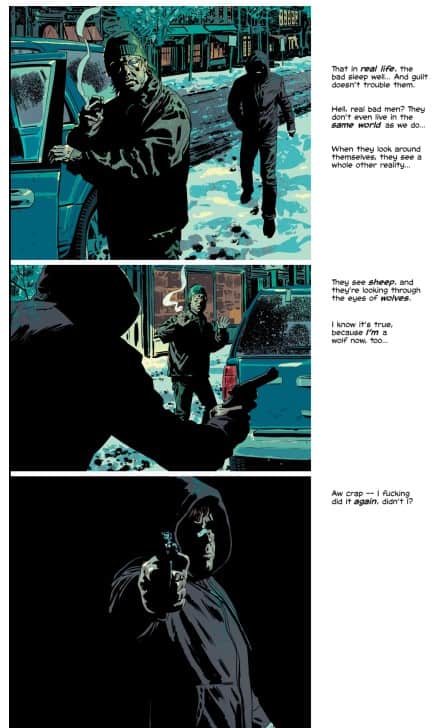
Brubaker is subtly suggesting that Dylan is not the most reliable of narrators. #1 left open the possibility that the demon was an imaginary fever dream, while #2 hints that Dylan is imagining the confirmation necessary to sleep more soundly at night. Dylan never comes off as pulp architype, such as the naïve looser or the world-weary tough guy. Instead, he is an achingly human character who speaks with a mixture of bitterness and tenderness. Most importantly, like Scheherazade all those centuries ago, he can spin one helluva captivating narrative.
Scheherazade only had words to weaver her tales, while Brubaker has the aid of such artistic masters as Sean Phillips and colorist Elizabeth Breitweiser. Both Phillips and Breitweiser have long careers behind them at this point, much of which has been spent in collaboration with Brubaker. Yet, like Brubaker, they are not content to rest on their laurels. Brubaker’s script allows Phillips to do something different with the layouts in Kill or Be Killed. For sections of the book, the text is pushed off panel, into the gutter, leaving the image bare of text. Isolating the panels also serves to weaken the connection between them. As Dylan relates events, there is a greater sense of dislocation, memory leaping from one moment to another, which reflects Dylan’s own mental processes.
In addition, Phillips and Breitweiser demonstrate their usual flair for atmosphere. While Brubaker’s words are enchanting, they are not the sole element which draws the reader into the story. The art is equally responsible. The opening monologue about One Thousand and One Nights accompanies images of Dylan stalking his latest prey. Dylan is isolated; at first glimpse, his face is entirely obscured by shadow. There is snow on the ground and palette is full of cold, wintry hues. This sets the register for most of the issue. However, at choice moments, Phillips and Breitweiser, shift the tone, softening the edges and allowing in brighter colors. The most striking example of this is a page showing the type of illustrative work Dylan’s dad did for a living. It is rendered in grand, lush style easily conveying the sense of wonder which captivated the younger Dylan, For Dylan it is reminiscent a more innocent time; for his father, who aspired to more prestigious labor, it represented failure. Once again, nothing is as clear-cut as it initially appears.
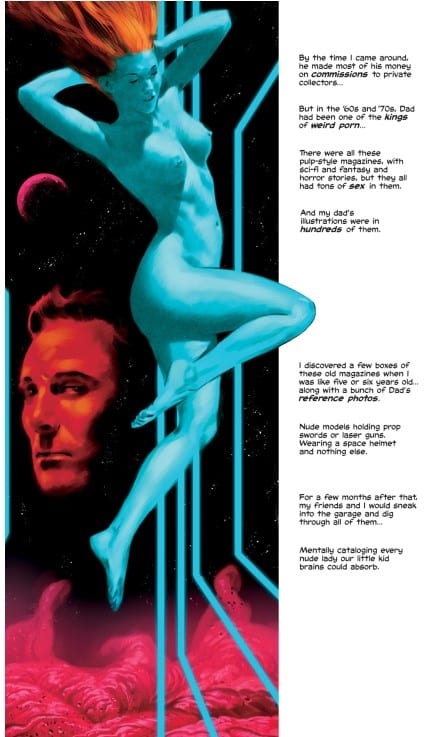
This layering is the source for much of Kill or Be Killed’s richness. The premise is easily described (as the title states, Dylan must kill others or die himself), yet the execution offers so much more. It is a vibrant, captivating story, which seizes the reader from the first page and does not let ago until the end, after which it lingers in the mind. For that reason, it is This Week’s Finest.






